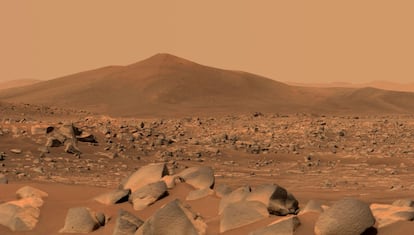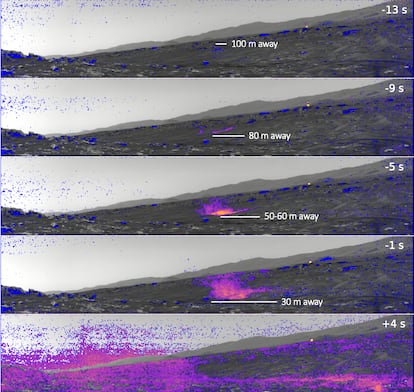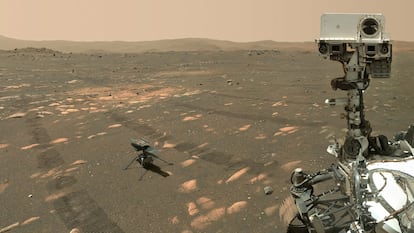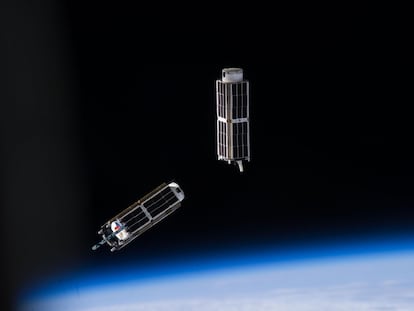NASA’s ‘Perseverance’ rover captures first recording of a dust storm on Mars
Multisensorial analysis of the 120-meter high whirlwind provides valuable information about the atmosphere of the Red Planet and can aid future manned missions
The stillness that emanates from images sent back to Earth from Mars does not correspond to reality: the landscape of the Red Planet may be dead, but it is still active. Now, for the first time, NASA and an international consortium of scientists have managed to capture the sound of a Martian dust swirl. The frequency of these eddies presents a challenge for the rovers sent there by mankind, as they can experience malfunctions when sand seeps into their electronic innards.
The registered whirlwind occurred in the Jezero crater in September 2021, where the Perseverance rover has been stationed since last year in search of active evidence of the presence of liquid water millions of years ago and, perhaps, life on Mars. The meteorological phenomenon reached 118 meters in height and 25 meters in diameter, ten times larger than the NASA vehicle, which was completely engulfed by the storm.

“We had a one in 200 chance of registering it,” says planetologist Naomi Murdoch, from the National Higher French Institute of Aeronautics and Space at the University of Toulouse, who is leading the research. “There was a lot of planning, but also luck: the microphone takes measurements for a little less than three minutes and a priori it is unknown when a dust devil is going to occur.”
The recording of the event and the data measurements have been published in the scientific journal Nature Communications. One of the paper’s co-authors, physicist Ricardo Hueso of the Planetary Sciences Group at the University of the Basque Country (UPV/EHU), says of the finding: “It is a unique event: the sound of a dust whirl had not been recorded before. We didn’t think we were going to capture it with all the instruments at once.”
“The findings may improve our understanding of surface changes, dust storms and climate variability on Mars, which may have implications for future space exploration,” Hueso, who is in charge of analyzing the atmospheric pressure data recorded, adds.

Perseverance is a technical feat that involved international cooperation throughout its development, such as the construction of the environmental measurement sensors (MEDA) at the Astrobiology Center of the Spanish National Research Council. Physicist Álvaro Vicente-Retortillo, who also participated in the study, explains that what makes this discovery special is having managed to record the chance encounter multisensorially: wind, pressure, air temperature, solar and thermal radiation from the surface, relative humidity of the environment, as well as images of the vortex itself. “MEDA provides very valuable information to better understand the properties of dust on Mars, which is important because of its implications for mission performance and, in the long term, for human health,” he says.
Dust is a constant in the tenuous Martian atmosphere, as the planet’s entire climate is conditioned by high concentrations of carbon dioxide. Physicist Victor Apéstigue compares the landscape to an earthly phenomenon: the Saharan dust cloud that affected the Iberian Peninsula earlier this year and extended in huge plumes across the Atlantic to the Americas. “On Mars, the greenhouse effect is constant and dust is one of its main agents, which causes solar radiation to be trapped inside the atmosphere,” says physicist Daniel Toledo. Both scientists belong to the group of specialists who control some of Perseverance’s sensors from the National Institute of Aerospace Technology (INTA) in Madrid, another center attached to the NASA mission on Mars and a partner in this research.
The rapid oxidation Martian dust causes on the instruments sent by NASA to the Red Planet has historically been a constant problem faced by scientists, according to INTA. All the more reason, the institute adds, to study the behavior of dust storms.

Perseverance’s cutting-edge technology has even been able to “distinguish the impacts of grains of sand from the sound of the air in the microphone on Mars, hundreds of them,” says Murdoch. The lead researcher points out that the results open the door to being able to analyze the planets of the Solar System from new angles for future manned missions: “Since we arrived on Mars in February and recorded the first sounds, we have not been disappointed: sound information from another planet has the potential to contribute to scientific knowledge.”
Sign up for our weekly newsletter to get more English-language news coverage from EL PAÍS USA Edition
Tu suscripción se está usando en otro dispositivo
¿Quieres añadir otro usuario a tu suscripción?
Si continúas leyendo en este dispositivo, no se podrá leer en el otro.
FlechaTu suscripción se está usando en otro dispositivo y solo puedes acceder a EL PAÍS desde un dispositivo a la vez.
Si quieres compartir tu cuenta, cambia tu suscripción a la modalidad Premium, así podrás añadir otro usuario. Cada uno accederá con su propia cuenta de email, lo que os permitirá personalizar vuestra experiencia en EL PAÍS.
¿Tienes una suscripción de empresa? Accede aquí para contratar más cuentas.
En el caso de no saber quién está usando tu cuenta, te recomendamos cambiar tu contraseña aquí.
Si decides continuar compartiendo tu cuenta, este mensaje se mostrará en tu dispositivo y en el de la otra persona que está usando tu cuenta de forma indefinida, afectando a tu experiencia de lectura. Puedes consultar aquí los términos y condiciones de la suscripción digital.
More information
Últimas noticias
ChatGPT fails the test: This is how it endangers the lives of minors
The late consecration of women artists in their 90s
The Florida Keys tourist paradise is besieged by immigration agents: ‘We’ve never seen anything like this’
The latest scam on WhatsApp behind the legal dream: using immigration status as bait
Most viewed
- Families demand repatriation of bodies of Colombians who died in Ukraine: ‘This war is a slaughterhouse for foreigners’
- The low-cost creative revolution: How technology is making art accessible to everyone
- Liset Menéndez de la Prida, neuroscientist: ‘It’s not normal to constantly seek pleasure; it’s important to be bored, to be calm’
- Christian Louboutin: ‘Young people don’t want to be like their parents. And if their parents wear sneakers, they’re going to look for something else’
- ‘El Limones’ and the growing union disguise of Mexican organized crime











































